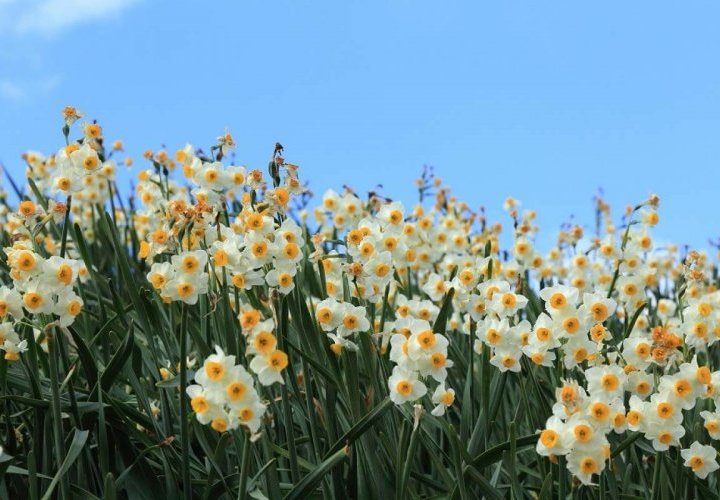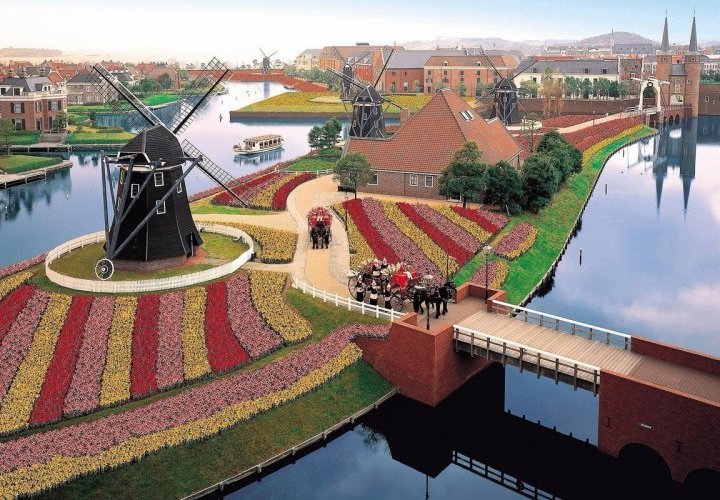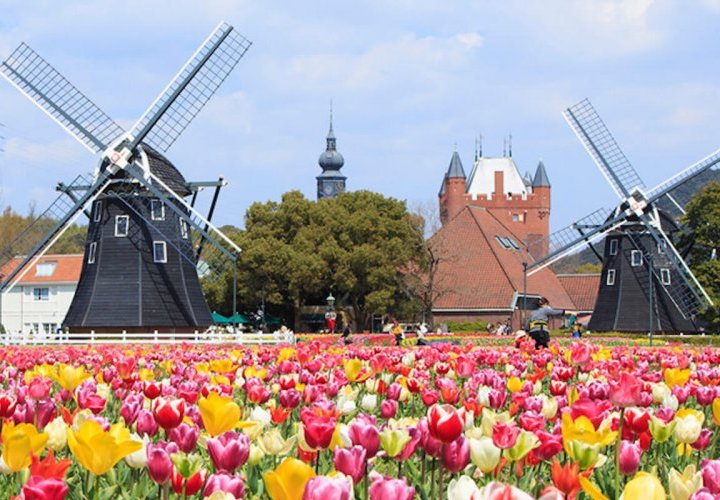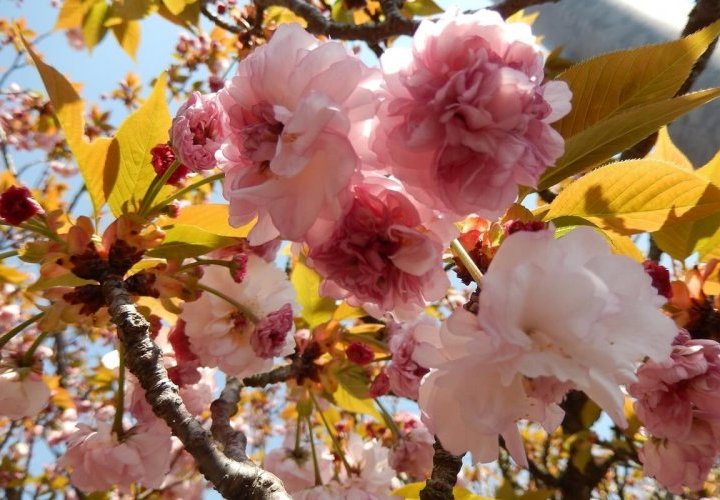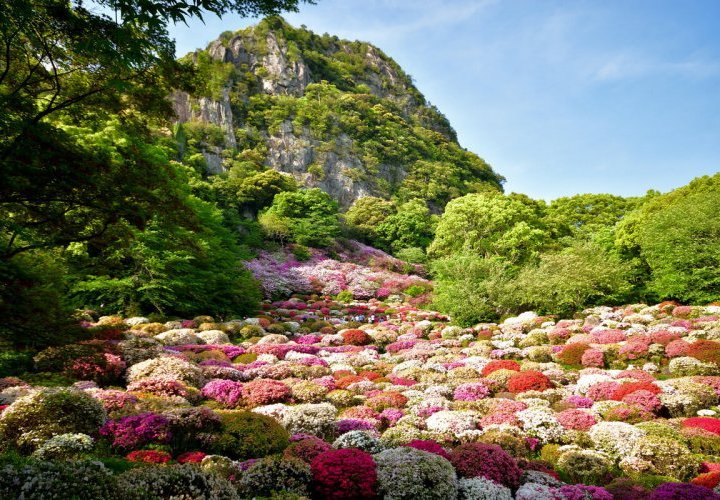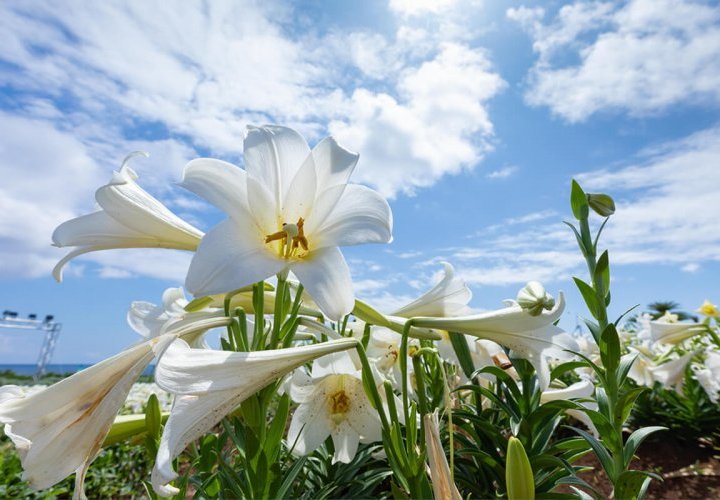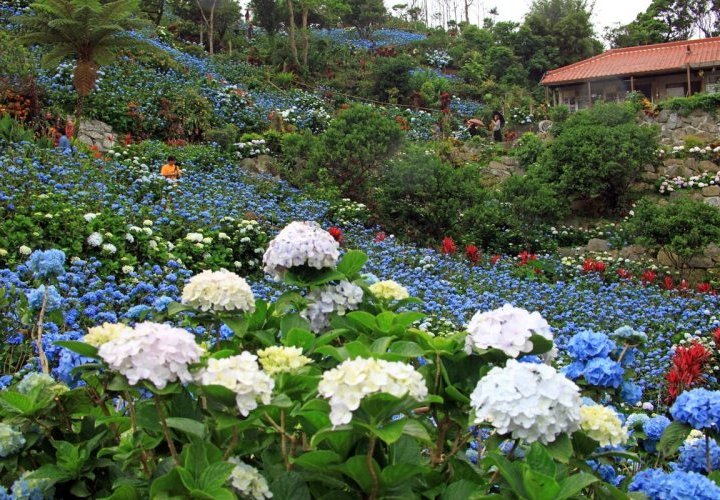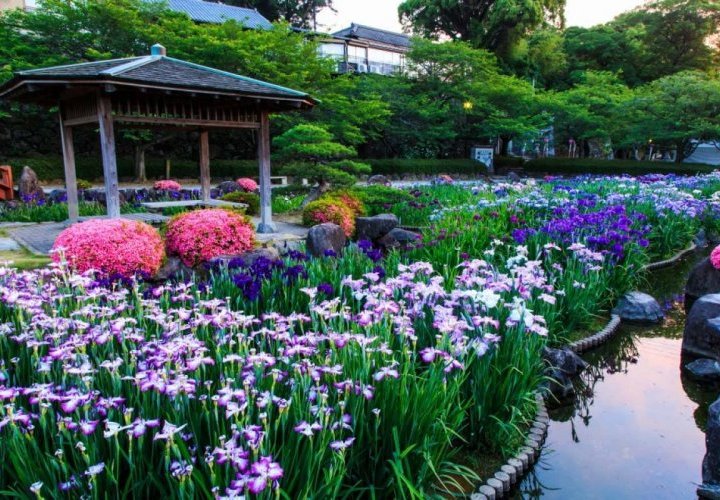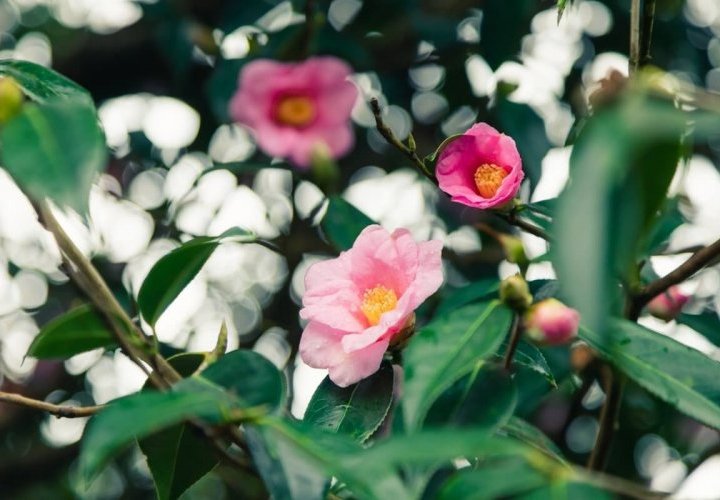Daffodil in Nomozaki Suisen no Sato Park, Nagasaki (late December to late January)
Nomozaki Suisen no Sato Park is located in Nagasaki city, at the southern tip of the Nagasaki Peninsula and offers a stunning view of around 10 million daffodils in bloom from late December to late January. The scent of the daffodils carried by the salty sea breeze was chosen as one of the “100 Scents of Japan” by the Ministry of Environment. Nomozaki Daffodil Festival held from the beginning of January in the park offers you the opportunity to immerse yourself in the pleasant scent of daffodils and witness the beautiful view of the sea surrounding Nomozaki area.
Tulip in Huis Ten Bosch Park, Sasebo (early February to mid-April)
Huis Ten Bosch is a theme park in Sasebo city, more
Nomozaki Suisen no Sato Park is located in Nagasaki city, at the southern tip of the Nagasaki Peninsula and offers a stunning view of around 10 million daffodils in bloom from late December to late January. The scent of the daffodils carried by the salty sea breeze was chosen as one of the “100 Scents of Japan” by the Ministry of Environment. Nomozaki Daffodil Festival held from the beginning of January in the park offers you the opportunity to immerse yourself in the pleasant scent of daffodils and witness the beautiful view of the sea surrounding Nomozaki area.
Tulip in Huis Ten Bosch Park, Sasebo (early February to mid-April)
Huis Ten Bosch is a theme park in Sasebo city, more
Nagasaki Prefecture, which recreates a Dutch city and was named after one of the residences of the Dutch Royal Family. The park is very spacious and stands out by its charming beautiful European style architecture, canals, flower gardens, iconic windmills, forest, restaurants, cafés, hotels, shops, museum, rides, harbour, theatre, etc.
Huis Ten Bosch Park looks spectacular from early February to mid-April when about 1 million tulips of 700 varieties (including 20 rare varieties) come into bloom. The tulip viewing spots are as follows: Flower Road, which offers a perfect setting for tulip viewing with Dutch windmills in the backdrop, Amsterdam Square or the so called Tulip Square, where you can enjoy a cup of coffee while viewing the coloured tulips around and Huis Ten Bosch Palace where you will see the replica of the beautiful Huis Ten Bosch Palace of The Hague, Netherlands and a lot of tulips of different varieties that shine the palace grounds.
Huis Ten Bosch Tulip Festival held during the blooming season is one of the most popular floral festivals in Japan. During the event, you can enjoy guided tours and workshops including tulip bouquet making, visit the many attractions of the area, savour a meal at one of the many restaurants or relax in a leisure boat touring the canals. During the evening, you will have the possibility to admire the tulip gardens illuminated with thousands of lights that will create a very romantic atmosphere.
Plum blossoms in Hitoyoshi Plum Garden, Hitoyoshi (late February to mid-March)
About 4,600 plum trees cover with their white and pink blossoms the 8-hectare area of Hitoyoshi Plum Garden from late February to mid-March. Every year, the Plum Festival is held here at the best time to see the blossoms. You can also enjoy plum picking in May at the location.
Camellia in Tsubakiyama Forest Park, Miyazaki (late February to mid-March)
The Camellia Garden of Tsubakiyama Forest Park is known for its 48,000 camellia trees of 1,000 cultivars and was authorized as the first International Camellia Garden of Excellence in Japan in March 2003. There is an observation deck on the hill of the park (at the altitude of 400 m), which provides a panoramic view of its natural attractions. You can enjoy the beautiful camellias while hearing the song of birds such as the white-eyes and bush-warblers that are searching for the camellia nectar.
Camellia in Oita Agricultural Park, Kitsuki (mid-March to early April)
Oita Agricultural Park is located in Kitsuki town, Oita Prefecture in the northeastern part of Kyushu. It was established in April, 2001 and is visited by many people who want to see various plants including camellias, Japanese apricots, cherries, peaches, dogwoods, cotton roses, etc.
The Camellia Garden that lies on an area of 2.2 ha has more than 1,000 camellias of 400 cultivars and species. The most impressive camellias in the garden are the distinguished large trees of “Tama-no-ura”, collections of Edo camellias, wabisuke camellias, fragrant camellias and Japanese camellias. More than 200 Japanese camellias are at their best from mid-March to early April.
Tulip in Florante Miyazaki Flower Park, Miyazaki (mid-March to mid-April)
Florante Miyazaki Flower Park is an urban-type botanical garden created as an excellent flower town where you will enjoy flowers all year round, from tulips, petunias, and Yoshino cherry blossoms in spring to sunflowers and hibiscuses in summer, salvia, marigold and cosmos in autumn, and pansies, Christmas roses, and plum blossoms in winter. About 100,000 tulips of 80 varieties bloom beautifully in the park from mid-March to mid-April.
Cherry blossoms in Omura Park, Omura (late March to early April)
Built over the outer moat of Kushima Castle, Omura Park turns into a sea of pink-petalled flowers in spring. The park is listed as one of Japan’s top 100 Famous Cherry Blossom-viewing spots offering unique sensations during the blooming season. Over 2,000 sakura cherry trees come into bloom from late March to early April in the park, signaling the start of spring.
A special type of cherry called “Omura zakura” found in the park, has unique blooms in two layers of petals (like two yaezakura on top of each other) and was designated a natural monument. Unlike the standard 5-sepal sakura, “Omura zakura” variety has ten sepals and can have from 60 up to 200 petals per flower! This type of cherry flower is extremely elegant and refined and has an appearance similar to that of a rose, making it a rare cherry blossom that even the Japanese do not usually see. Therefore, if you decide to travel to Omura city, Nagasaki Prefecture, during the cherry blossom season, Omura Park is a must-see attraction. There are about 300 “Omura zakura” trees planted within Omura Park that will certainly impress you with their elegant blossoms.
Cherry blossoms in Maizuru Park, Fukuoka (late March to early April)
Maizuru Park is one of the most famous cherry blossom spots in Fukuoka city. The park was built around the ruins of Fukuoka Castle and is home to about 1,000 Yoshino cherry trees and Weeping cherry trees that bloom from late March to early April. During the season, Fukuoka Castle Cherry Blossom Festival is held in the park, allowing visitors to admire the cherry blossoms that add color to the stone walls of the castle. Both the cherry blossoms and the walls of Fukuoka Castle are lit-up during the festival, creating an exciting atmosphere in the park.
Cherry blossoms in Mifuneyama Rakuen Garden, Takeo (late March to early April)
Mifuneyama Rakuen Garden is a very large garden in Takeo city, Saga Prefecture, covering an area of over 500,000 square meters. It was opened in 1845 and its name stems from the beautiful view of Mount Mifuneyama. About 5,000 cherry trees including Yoshino cherries, Oshima cherries, mountain cherries and double-flowered cherries bloom in succession within the garden from late March to early April.
A two-acre span of 2,000 cherries at the foot of Mt. Mifuneyama is lit up with special lights at night, making this the Kyushu area’s largest event of this kind. The hotels and hot springs inns offer a great opportunity to enjoy first a dip in the hot springs and then a relaxing garden walk while wearing a Japanese yukata.
Besides the cherry blossoms, there are many other attractions to see within the garden including a teahouse and over 500 statues of Buddhist saints and 200,000 azaleas, wisterias (white and purple) and rhododendrons from mid-April to early May.
Cherry blossoms at Isshinji Temple, Oita (early to late April)
Isshinji Temple is located at a valley surrounded by mountains in Oita city. More than 15 kinds of special Yaezakura (double cherry blossoms) such as green, yellow and purple Sakura bloom all over the valley from early to late April. The flowers in the valley are magnificent being often described as a sea of cherry blossom clouds.
Azalea in Nagushiyama Park, Sasebo (early April to early May)
Nagushiyama Park located in Sasebo city, Nagasaki Prefecture, offers you a spectacular view of thousands of azalea flowers, hundreds of big and small islands and the blue sea at the same time. From the 234-metre peak of Mt. Nagushiyama you will see over 100,000 Kurume azaleas and Hirado azaleas with the northern Kujuku Islands in far distance. The azaleas are in bloom from early-April to early-May and there is also a camping area, a small restaurant inside the visitor’s centre and a play area for children.
Rhododendron in Urami Waterfall Flower Garden, Omura (early April to mid-May)
Urami Waterfall Flower Garden is a sightseeing spot in Omura city, Nagasaki Prefecture, located about 3.8 km east of Matsubara Station. About 5,400 rhododendrons of 45 different kinds from around the world bloom from early April to mid-May in the garden. During the blooming season, Rhododendron Festival is held in the garden and you can enjoy the markets with local products, rhododendrons and photos/haiku competitions.
Nemophila in Uminonakamichi Seaside Park, Fukuoka (mid to late April)
Uminonakamichi Seaside Park is a large national park that stretches about six kilometres from east to west on a total area of about 300 hectares. There are many things to enjoy in the park including beautiful seasonal flowers all year round, as well as various activities where you can interact with animals, including squirrel, monkeys and capybaras. Nemophila (baby blue eyes) flowers that grow on the Flower Hill offer the most popular view in spring and are certainly a must-see. Over 1,500,000 beautiful baby blue eyes flowers colour the hill in pale blue and create an impressive blue scenery as far as the eye can see.
Tulip in Kuju Flower Park, Takeda (mid-April to early May)
Located at the southern base of the Kuju Mountains at an altitude of 850 m, Kuju Flower Park (Kuju Hana Koen) offers stunning seasonal displays of flowers set against beautiful mountain scenery. It is a large, attractive park, which covers 49 acres of land and is home to about three million plants of more than 500 different varieties.
Many seasonal flowers bloom for most of the year in the park, except winter. About 100,000 red, yellow and white tulips announce the beginning of spring and bloom beautifully from mid-April to early May in Kuju Flower Park. You can also enjoy poppies (mid-April to early June), roses (late May to mid-June), lavender (early June to early July), Casablanca lilies (mid-July to early August), hydrangeas (mid to late July), cosmos (early to mid-October) and marigolds (mid-October to early November) in bloom in the park. From early July to mid-September, blueberry picking is available from the bushes that grow here (over 3000 blueberry bushes of 10 different varieties). From mid to late October, you will experience an extraordinary scenery of Chestnut Tiger Butterflies that visit Kuju Flower Park on their migration route of over 2,200 km.
There is also a good selection of cafés and restaurants where you can find ice cream and soft cream in seasonal flavours such as lavender and blueberry, handmade bread and healthy teas made from wild grasses and herbs.
Azalea in Mifuneyama Rakuen Garden, Takeo (mid-April to early May)
The signature of Mifuneyama Rakuen Garden is the bowl-shaped azalea valley, which is filled with azaleas of different colours creating a stunning view. About 200,000 azaleas of different types such as the Kurume and Hirado give the garden a brilliant colour from mid-April to early May. A flower-viewing platform that stands about 30 metres above ground has been installed to the left of Mt. Mifuneyama, allowing you to experience a truly magnificent view of the azaleas.
Poppy at Ikoma Kogen Plateau, Kobayashi (mid-April to early May)
Ikoma Kogen is an expansive plateau in Kobayashi city that stretches out at the foot of Mt. Kirishima. About 250,000 red, yellow, orange and white Iceland poppies cover the fields in vivid colours from mid-April to early May. The contrast of the blue sky and the multi-coloured carpet of delightful blossoms is truly breathtaking.
Lily in the Lily Field Park, Ie (late April to early May)
The earliest lilies bloom in Japan can be seen in the Lily Field Park of Ie village in Okinawa. Ie Island is a small island with about 5,000 residents and a 30-minute ferry ride west from Motobu known as a quiet place with nice white beaches, the largest Hibiscus farm of Okinawa and slow-life atmosphere. The Lily Field Park is home to over one million lilies that cover the area with white, fragrant carpets from late April to early May. The brilliant white lilies contrasting with the deep blue sky and turquoise Paicific Ocean create a magnificent view. During the blooming season, the annual Ie lsland Lily Festival is held in the park offering visitors the possibility to see the lilies, enjoy a unique tasting experience at the food and drink stalls, as well as various music and dance performances.
Wisteria in Kawachi Wisteria Garden, Kitakyushu (late April to early May)
Kawachi Wisteria Garden located in Kitakyushu city, Fukuoka Prefecture offers a breathtaking scenery of over 20 kinds of wisterias on an area of 10,000 square metres. Opened in 1977, Kawachi Wisteria (Fuji) Garden was chosen by CNN as one of the “31 Most Beautiful Places in Japan”. The best highlights of the garden are the two stunning tunnels made with beautiful wisterias: one is 80 m long and the other one is 110 m long. The best time to see wisteria and capture the full blooming is from late April to early May.
Huis Ten Bosch Park looks spectacular from early February to mid-April when about 1 million tulips of 700 varieties (including 20 rare varieties) come into bloom. The tulip viewing spots are as follows: Flower Road, which offers a perfect setting for tulip viewing with Dutch windmills in the backdrop, Amsterdam Square or the so called Tulip Square, where you can enjoy a cup of coffee while viewing the coloured tulips around and Huis Ten Bosch Palace where you will see the replica of the beautiful Huis Ten Bosch Palace of The Hague, Netherlands and a lot of tulips of different varieties that shine the palace grounds.
Huis Ten Bosch Tulip Festival held during the blooming season is one of the most popular floral festivals in Japan. During the event, you can enjoy guided tours and workshops including tulip bouquet making, visit the many attractions of the area, savour a meal at one of the many restaurants or relax in a leisure boat touring the canals. During the evening, you will have the possibility to admire the tulip gardens illuminated with thousands of lights that will create a very romantic atmosphere.
Plum blossoms in Hitoyoshi Plum Garden, Hitoyoshi (late February to mid-March)
About 4,600 plum trees cover with their white and pink blossoms the 8-hectare area of Hitoyoshi Plum Garden from late February to mid-March. Every year, the Plum Festival is held here at the best time to see the blossoms. You can also enjoy plum picking in May at the location.
Camellia in Tsubakiyama Forest Park, Miyazaki (late February to mid-March)
The Camellia Garden of Tsubakiyama Forest Park is known for its 48,000 camellia trees of 1,000 cultivars and was authorized as the first International Camellia Garden of Excellence in Japan in March 2003. There is an observation deck on the hill of the park (at the altitude of 400 m), which provides a panoramic view of its natural attractions. You can enjoy the beautiful camellias while hearing the song of birds such as the white-eyes and bush-warblers that are searching for the camellia nectar.
Camellia in Oita Agricultural Park, Kitsuki (mid-March to early April)
Oita Agricultural Park is located in Kitsuki town, Oita Prefecture in the northeastern part of Kyushu. It was established in April, 2001 and is visited by many people who want to see various plants including camellias, Japanese apricots, cherries, peaches, dogwoods, cotton roses, etc.
The Camellia Garden that lies on an area of 2.2 ha has more than 1,000 camellias of 400 cultivars and species. The most impressive camellias in the garden are the distinguished large trees of “Tama-no-ura”, collections of Edo camellias, wabisuke camellias, fragrant camellias and Japanese camellias. More than 200 Japanese camellias are at their best from mid-March to early April.
Tulip in Florante Miyazaki Flower Park, Miyazaki (mid-March to mid-April)
Florante Miyazaki Flower Park is an urban-type botanical garden created as an excellent flower town where you will enjoy flowers all year round, from tulips, petunias, and Yoshino cherry blossoms in spring to sunflowers and hibiscuses in summer, salvia, marigold and cosmos in autumn, and pansies, Christmas roses, and plum blossoms in winter. About 100,000 tulips of 80 varieties bloom beautifully in the park from mid-March to mid-April.
Cherry blossoms in Omura Park, Omura (late March to early April)
Built over the outer moat of Kushima Castle, Omura Park turns into a sea of pink-petalled flowers in spring. The park is listed as one of Japan’s top 100 Famous Cherry Blossom-viewing spots offering unique sensations during the blooming season. Over 2,000 sakura cherry trees come into bloom from late March to early April in the park, signaling the start of spring.
A special type of cherry called “Omura zakura” found in the park, has unique blooms in two layers of petals (like two yaezakura on top of each other) and was designated a natural monument. Unlike the standard 5-sepal sakura, “Omura zakura” variety has ten sepals and can have from 60 up to 200 petals per flower! This type of cherry flower is extremely elegant and refined and has an appearance similar to that of a rose, making it a rare cherry blossom that even the Japanese do not usually see. Therefore, if you decide to travel to Omura city, Nagasaki Prefecture, during the cherry blossom season, Omura Park is a must-see attraction. There are about 300 “Omura zakura” trees planted within Omura Park that will certainly impress you with their elegant blossoms.
Cherry blossoms in Maizuru Park, Fukuoka (late March to early April)
Maizuru Park is one of the most famous cherry blossom spots in Fukuoka city. The park was built around the ruins of Fukuoka Castle and is home to about 1,000 Yoshino cherry trees and Weeping cherry trees that bloom from late March to early April. During the season, Fukuoka Castle Cherry Blossom Festival is held in the park, allowing visitors to admire the cherry blossoms that add color to the stone walls of the castle. Both the cherry blossoms and the walls of Fukuoka Castle are lit-up during the festival, creating an exciting atmosphere in the park.
Cherry blossoms in Mifuneyama Rakuen Garden, Takeo (late March to early April)
Mifuneyama Rakuen Garden is a very large garden in Takeo city, Saga Prefecture, covering an area of over 500,000 square meters. It was opened in 1845 and its name stems from the beautiful view of Mount Mifuneyama. About 5,000 cherry trees including Yoshino cherries, Oshima cherries, mountain cherries and double-flowered cherries bloom in succession within the garden from late March to early April.
A two-acre span of 2,000 cherries at the foot of Mt. Mifuneyama is lit up with special lights at night, making this the Kyushu area’s largest event of this kind. The hotels and hot springs inns offer a great opportunity to enjoy first a dip in the hot springs and then a relaxing garden walk while wearing a Japanese yukata.
Besides the cherry blossoms, there are many other attractions to see within the garden including a teahouse and over 500 statues of Buddhist saints and 200,000 azaleas, wisterias (white and purple) and rhododendrons from mid-April to early May.
Cherry blossoms at Isshinji Temple, Oita (early to late April)
Isshinji Temple is located at a valley surrounded by mountains in Oita city. More than 15 kinds of special Yaezakura (double cherry blossoms) such as green, yellow and purple Sakura bloom all over the valley from early to late April. The flowers in the valley are magnificent being often described as a sea of cherry blossom clouds.
Azalea in Nagushiyama Park, Sasebo (early April to early May)
Nagushiyama Park located in Sasebo city, Nagasaki Prefecture, offers you a spectacular view of thousands of azalea flowers, hundreds of big and small islands and the blue sea at the same time. From the 234-metre peak of Mt. Nagushiyama you will see over 100,000 Kurume azaleas and Hirado azaleas with the northern Kujuku Islands in far distance. The azaleas are in bloom from early-April to early-May and there is also a camping area, a small restaurant inside the visitor’s centre and a play area for children.
Rhododendron in Urami Waterfall Flower Garden, Omura (early April to mid-May)
Urami Waterfall Flower Garden is a sightseeing spot in Omura city, Nagasaki Prefecture, located about 3.8 km east of Matsubara Station. About 5,400 rhododendrons of 45 different kinds from around the world bloom from early April to mid-May in the garden. During the blooming season, Rhododendron Festival is held in the garden and you can enjoy the markets with local products, rhododendrons and photos/haiku competitions.
Nemophila in Uminonakamichi Seaside Park, Fukuoka (mid to late April)
Uminonakamichi Seaside Park is a large national park that stretches about six kilometres from east to west on a total area of about 300 hectares. There are many things to enjoy in the park including beautiful seasonal flowers all year round, as well as various activities where you can interact with animals, including squirrel, monkeys and capybaras. Nemophila (baby blue eyes) flowers that grow on the Flower Hill offer the most popular view in spring and are certainly a must-see. Over 1,500,000 beautiful baby blue eyes flowers colour the hill in pale blue and create an impressive blue scenery as far as the eye can see.
Tulip in Kuju Flower Park, Takeda (mid-April to early May)
Located at the southern base of the Kuju Mountains at an altitude of 850 m, Kuju Flower Park (Kuju Hana Koen) offers stunning seasonal displays of flowers set against beautiful mountain scenery. It is a large, attractive park, which covers 49 acres of land and is home to about three million plants of more than 500 different varieties.
Many seasonal flowers bloom for most of the year in the park, except winter. About 100,000 red, yellow and white tulips announce the beginning of spring and bloom beautifully from mid-April to early May in Kuju Flower Park. You can also enjoy poppies (mid-April to early June), roses (late May to mid-June), lavender (early June to early July), Casablanca lilies (mid-July to early August), hydrangeas (mid to late July), cosmos (early to mid-October) and marigolds (mid-October to early November) in bloom in the park. From early July to mid-September, blueberry picking is available from the bushes that grow here (over 3000 blueberry bushes of 10 different varieties). From mid to late October, you will experience an extraordinary scenery of Chestnut Tiger Butterflies that visit Kuju Flower Park on their migration route of over 2,200 km.
There is also a good selection of cafés and restaurants where you can find ice cream and soft cream in seasonal flavours such as lavender and blueberry, handmade bread and healthy teas made from wild grasses and herbs.
Azalea in Mifuneyama Rakuen Garden, Takeo (mid-April to early May)
The signature of Mifuneyama Rakuen Garden is the bowl-shaped azalea valley, which is filled with azaleas of different colours creating a stunning view. About 200,000 azaleas of different types such as the Kurume and Hirado give the garden a brilliant colour from mid-April to early May. A flower-viewing platform that stands about 30 metres above ground has been installed to the left of Mt. Mifuneyama, allowing you to experience a truly magnificent view of the azaleas.
Poppy at Ikoma Kogen Plateau, Kobayashi (mid-April to early May)
Ikoma Kogen is an expansive plateau in Kobayashi city that stretches out at the foot of Mt. Kirishima. About 250,000 red, yellow, orange and white Iceland poppies cover the fields in vivid colours from mid-April to early May. The contrast of the blue sky and the multi-coloured carpet of delightful blossoms is truly breathtaking.
Lily in the Lily Field Park, Ie (late April to early May)
The earliest lilies bloom in Japan can be seen in the Lily Field Park of Ie village in Okinawa. Ie Island is a small island with about 5,000 residents and a 30-minute ferry ride west from Motobu known as a quiet place with nice white beaches, the largest Hibiscus farm of Okinawa and slow-life atmosphere. The Lily Field Park is home to over one million lilies that cover the area with white, fragrant carpets from late April to early May. The brilliant white lilies contrasting with the deep blue sky and turquoise Paicific Ocean create a magnificent view. During the blooming season, the annual Ie lsland Lily Festival is held in the park offering visitors the possibility to see the lilies, enjoy a unique tasting experience at the food and drink stalls, as well as various music and dance performances.
Wisteria in Kawachi Wisteria Garden, Kitakyushu (late April to early May)
Kawachi Wisteria Garden located in Kitakyushu city, Fukuoka Prefecture offers a breathtaking scenery of over 20 kinds of wisterias on an area of 10,000 square metres. Opened in 1977, Kawachi Wisteria (Fuji) Garden was chosen by CNN as one of the “31 Most Beautiful Places in Japan”. The best highlights of the garden are the two stunning tunnels made with beautiful wisterias: one is 80 m long and the other one is 110 m long. The best time to see wisteria and capture the full blooming is from late April to early May.
Hydrangea in Yohena Hydrangea Garden, Motobu (mid-May to mid-June)
Yohena Hydrangea Garden is located in Motobu town in northern Okinawa Prefecture. The garden has originally been a tangerine field before its owner, Mrs. Uto Yohena started to plant hydrangeas and they grew covering the whole garden. Now there are more than 300,000 hydrangeas of nearly 30 species blooming all over the garden in purple, blue, pink and white colours over an area of 10,000 square metres. The garden was selected as one of the 30 Best Hydrangeas Gardens in Western Japan and draws a large number of visitors from all over the world.
Iris in Omura Park, Omura (late May to mid-June)
About 300, more
Yohena Hydrangea Garden is located in Motobu town in northern Okinawa Prefecture. The garden has originally been a tangerine field before its owner, Mrs. Uto Yohena started to plant hydrangeas and they grew covering the whole garden. Now there are more than 300,000 hydrangeas of nearly 30 species blooming all over the garden in purple, blue, pink and white colours over an area of 10,000 square metres. The garden was selected as one of the 30 Best Hydrangeas Gardens in Western Japan and draws a large number of visitors from all over the world.
Iris in Omura Park, Omura (late May to mid-June)
About 300, more
000 Japanese irises of 171 different kinds bloom at the Nagabori and Minamibori moats of Kushima Castle in Omura Park on an area of 9,500 square metres. This iris garden is one of the largest Japanese iris gardens in Kyushu and offers a spectacular sight of purple and blue irises blooming from late May to mid-June. At the beginning of June, the “Iris Festival” is held here being very popular among visitors from inside and outside Nagasaki Prefecture.
Cosmos at Ikoma Kogen Plateau, Kobayashi (mid-September to late October)
Located in Kobayashi city, Miayazaki Prefecture, Ikoma Kogen Plateau is a plateau with an altitude of 550 metres that extends out at the foot of Mt. Kirishima. Over 1,000,000 cosmos flowers of over 17 different types cover the plateau in pink, red and white colours from mid-September to late October. It becomes a splendid scenic spot for walking and taking amazing photos in autumn. A popular café located in the area will welcome you with its delicious soft-serve ice cream.
Cosmos in Nokonoshima Island Park, Nokonoshima (early to late October)
Nokonoshima Island Park stretches out on an area of about 150,000 square metres in the northern part of Nokonoshima Island. This island sits just in the middle of Hakata Bay and can be reached in just ten minutes by a city-operated ferry from Meinohama, Fukuoka. The park is filled with blossoming flowers such as daffodil, plum, cherry, poppy, hydrangea, cosmos, camellia, etc. all year round.
The cosmos flowers are especially popular and start blooming in early October. About 500,000 cosmos flowers cover the vast field creating a colourful carpet that contrasts with the blue of Hakata Bay. The magnificent view is a must-see for flower lovers. When the cosmos flowers come into bloom, the park becomes illuminated at night offering sceneries including the setting sun over Hakata Bay, city lights and dreamy cosmos flowers.
Cosmos at Ikoma Kogen Plateau, Kobayashi (mid-September to late October)
Located in Kobayashi city, Miayazaki Prefecture, Ikoma Kogen Plateau is a plateau with an altitude of 550 metres that extends out at the foot of Mt. Kirishima. Over 1,000,000 cosmos flowers of over 17 different types cover the plateau in pink, red and white colours from mid-September to late October. It becomes a splendid scenic spot for walking and taking amazing photos in autumn. A popular café located in the area will welcome you with its delicious soft-serve ice cream.
Cosmos in Nokonoshima Island Park, Nokonoshima (early to late October)
Nokonoshima Island Park stretches out on an area of about 150,000 square metres in the northern part of Nokonoshima Island. This island sits just in the middle of Hakata Bay and can be reached in just ten minutes by a city-operated ferry from Meinohama, Fukuoka. The park is filled with blossoming flowers such as daffodil, plum, cherry, poppy, hydrangea, cosmos, camellia, etc. all year round.
The cosmos flowers are especially popular and start blooming in early October. About 500,000 cosmos flowers cover the vast field creating a colourful carpet that contrasts with the blue of Hakata Bay. The magnificent view is a must-see for flower lovers. When the cosmos flowers come into bloom, the park becomes illuminated at night offering sceneries including the setting sun over Hakata Bay, city lights and dreamy cosmos flowers.
Rose in Kanoya Rose Garden, Kanoya (late April to early June; mid-November to early December)
Located in a hilly area in the east of Kirishimagaoka Park in Kanoya city, Kagoshima Prefecture, Kanoya Rose Garden is one of the largest rose gardens in Japan. About 35,000 wild roses, English roses, and other rose varieties including Kanoya’s own original Princess Kanoya grow and bloom in vivid colours on the vast grounds of the garden.
The best times to visit the garden are from late April to early June and from mid-November to early December. Twice a year, during the peak blooming periods, in spring and autumn, “Kanoya Rose Festival” is held in the garden. During the festival, the visitors can see roses from around the world in facilities like a rose chapel and garden stage and taste a wide variety of dishes made with roses at the restaurant of the garden. more
Located in a hilly area in the east of Kirishimagaoka Park in Kanoya city, Kagoshima Prefecture, Kanoya Rose Garden is one of the largest rose gardens in Japan. About 35,000 wild roses, English roses, and other rose varieties including Kanoya’s own original Princess Kanoya grow and bloom in vivid colours on the vast grounds of the garden.
The best times to visit the garden are from late April to early June and from mid-November to early December. Twice a year, during the peak blooming periods, in spring and autumn, “Kanoya Rose Festival” is held in the garden. During the festival, the visitors can see roses from around the world in facilities like a rose chapel and garden stage and taste a wide variety of dishes made with roses at the restaurant of the garden. more
Dishes such as “Rose Curry” and “Rose Soft-serve Ice Cream” are very popular among visitors.
Camellia in Kurume Camellia Garden, Kurume (mid-October to mid-April)
Located at the northern foot of the Mino Mountain Range, Kurume Camellia Garden was opened in March 2009 as a site for relaxation with flowers and green surroundings, aiming to promote the green industry and to regenerate the locality. The site was a former garden developed in the Meiji period and the old plants including old camellias have been kept. The 3-hectare garden is home to over 3,000 camellia trees of about 500 cultivars and species including camellias that were previously growing at the site. During “Kurume Camellia Fair” held here in the middle of March, you can enjoy visiting the private gardens and take advantage of the guided tours included in the program.
Camellia in Kurume Camellia Garden, Kurume (mid-October to mid-April)
Located at the northern foot of the Mino Mountain Range, Kurume Camellia Garden was opened in March 2009 as a site for relaxation with flowers and green surroundings, aiming to promote the green industry and to regenerate the locality. The site was a former garden developed in the Meiji period and the old plants including old camellias have been kept. The 3-hectare garden is home to over 3,000 camellia trees of about 500 cultivars and species including camellias that were previously growing at the site. During “Kurume Camellia Fair” held here in the middle of March, you can enjoy visiting the private gardens and take advantage of the guided tours included in the program.

